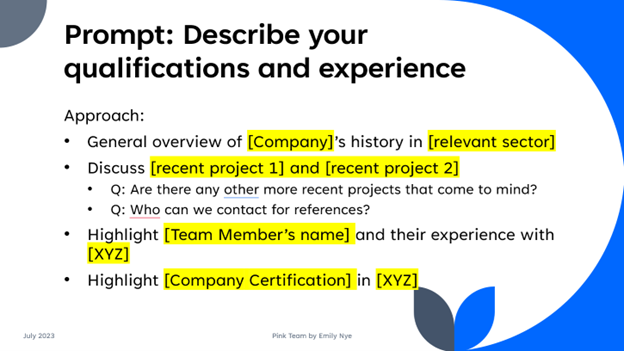Are you ready to incorporate Pink Team meetings into your proposal process? Do you already hold Pink Team meetings but feel they could be more productive? Is your team not participating or giving you the insight needed to move the narrative forward? After leading a handful of Pink Team meetings that seemed to miss the mark, I began to change my approach; now, I leave my Pink Team meetings feeling confident in my content plan and ready to tackle even the most challenging RFP prompts.
Note: Pink Team nomenclature used here isn’t the traditional “Shipley” Pink Team; at my organization, not all opportunities have a Capture Manager assigned or allow for a pre-RFP blue team. Instead, our “Pink Team” is a brainstorming session/Pink Team hybrid.
What is a Pink Team Meeting?
While everyone’s Pink Team meeting might function differently, as the one who manages the entire proposal process, I see the Pink Team meeting as my opportunity to get what I need from my team for the narrative and fill in any gaps. A Pink Team meeting can be a highly effective way to develop a strong content plan. Essentially, it’s a brainstorming meeting where you and your team determine how to best respond to prompts so that your proposal is compliant, compelling, and customer-centric.
When is the Pink Team Meeting?
If you follow a strict Shipley methodology, your Pink Team meeting will happen after your Blue Team Review. In the grand scheme of the entire proposal process, your Pink Team meeting should happen after the kick-off but before the majority of writing begins. Having your Pink Team meeting early in the proposal process ensures that you and your team are on the same page and have enough time to develop content.
Before a Pink Team
My biggest piece of advice for leading an effective pink team is to come prepared. To ensure that you have a productive, collaborative Pink Team, here’s an overview of what you should have accomplished beforehand:
Assign Tasks
Everyone should have a clear sense of purpose before the Pink Team meeting. When you know what you are responsible for, you can effectively lead your Pink Team meeting to get answers to your questions and develop a compliant, customer-centric narrative.
Develop Win Themes
Before the Pink Team meeting, your win themes should be established. You’ll spend time during your meeting figuring out how you can implement those win themes into the narrative while remaining compliant.
Create the Proposal Outline
Having a complete outline for your proposal is imperative to leading a successful pink team. Once you have your outline done, the gaps in your proposal become apparent. Outlining also helps you familiarize yourself with the prompts on a deeper level so that you can start independently brainstorming your approach for each section.
Develop Your Approach
You probably already have a general idea of how you’re going to respond to certain sections. Do you have a boilerplate that might fit and want feedback from the team? Is there another proposal that has a great response you can use? Do you have absolutely no clue how to respond to this section and need to brainstorm with the team? All of these things can be added to your Pink Team agenda to review with the team and gain feedback, insight, and clarity.
The more comprehensive your approach for each prompt is, the more your team can help you get your narrative in the right direction during the Pink Team meeting.
Choose Your Delivery Method and Create It
Don’t show up to your pink team empty-handed. To gain insight, receive feedback, and foster collaboration, giving your team something to look at and respond to is crucial. I recommend creating a slideshow with all of the narrative requirements you want to discuss. You can also go through your outline, but I think that creating a slideshow is easier to follow and maneuver.
If you are struggling to figure out what prompts to focus on, I’d recommend focusing on the following:
- Prompts you need an approach for
- Prompts you want to verify your approach for
- Prompts you have questions about
Tips for Creating Your Presentation
- Only show the team one prompt at a time
- Only showing one prompt at a time ensures that your team will not try to jump around
- Type up your approach below the prompt
- Putting down your ideas encourages feedback. Your approach can be as simple as “talk about [this feature]” to ensure you are on the right track, or you can begin plugging in content and showing them what you’ve done so far. Either way, you can receive feedback or discover new avenues to go down
- Insert what you have so far into your outline
- If you have narrative or design ideas ready to go, insert them into your outline. You can either pivot to your outline or take a screenshot for your slideshow to receive feedback
- Order the prompts from most important to least important
- If you have a prompt you have no idea how to answer, make sure to review that early on in the meeting. I insert my “if there’s time…” prompts at the end
Below is a basic example slide that incorporates a few of these tips.

Figure 1. Example Slide for Pink Team
You’ll find that if you follow some of these tips, your Pink Team meeting will be productive and collaborative.
During the Pink Team Meeting
When you come to your Pink Team meeting prepared, all you need to do during the meeting is pay attention and take notes. If you aren’t the best notetaker, ask your team if you can record the meeting. Because my Pink Team meetings are thorough, I find that my team members are highly engaged and suggest great ideas, and I don’t want to miss a thing.
After the Pink Team Meeting
After your Pink Team meeting, send a brief recap email with any important action items and continue working on your narrative. You should have everything necessary to continue drafting a customer-centric, thorough response.
Being prepared for your Pink Team meeting is the best way to ensure a collaborative effort and create customer-centric content. Follow some of the advice for leading an effective Pink Team and end your meeting feeling confident and ready to tackle even the most challenging prompts.
About the Author
Emily Nye is a government Proposal Specialist in the IT sector and holds an M.A. and B.A. in English. Emily’s education and experience bring meticulous attention to detail and a passion for clear and persuasive communication to every project. Connect with Emily on LinkedIn.




Join the Conversation